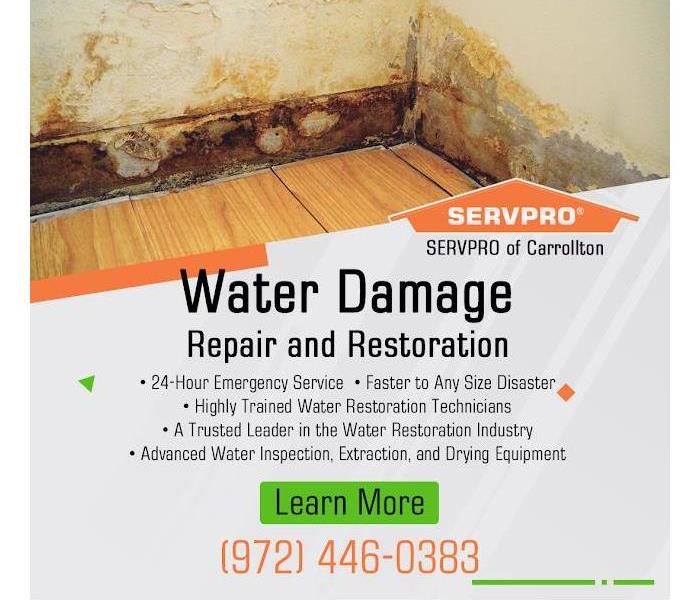Do I need to replace drywall after flood damage?
12/8/2022 (Permalink)
Homes can become flooded for a variety of reasons. Flood damage is usually caused by water from natural disasters (hurricanes, heavy rains), including flash floods, sump failures, roof leaks, and more.
Water damage refers to damage caused by water ingress that allows the destruction of materials and objects. Destructive processes with water include wood rot, metal rust, and mold growth. Drywall is a building material that is susceptible to water damage during flooding. It is made of gypsum board. Drywall is a building material used in residential and commercial properties. The material is strong enough when dry but is porous and will absorb water if exposed for long periods of time. Drywall is most susceptible to water damage when exposed to water for an extended period.
In this article, SERVPRO of Carrollton and Bent Tree in Far North Dallas explains why drywall should be replaced after flood damage.
SERVPRO of Carrollton is a locally owned and operated company that provides water damage restoration in Far North Dallas and surrounding areas.
Signs of water damage to drywall
- Soggy or damp areas that may be moist or soft to touch
- Bulging or sagging of drywall
- Loose bolts and screws around drywall
- Brown or dark discoloration or marks along where water leaked on the drywall
- Peeling or bubbled appearance of wallpaper
- Blistering or softening and chipped paint
- Moldy spots or patches
- The musty odor from trapped water in drywall
When should drywall be replaced?
The drywall should be thoroughly inspected if flooding or water damage is suspected.
Drywall is slightly wet
If the drywall is just slightly damp, it may not need to be replaced. However, quick drying of drywall is essential. Pointing a fan at the drywall will help dry it after turning off the water source. Opening a window will allow air to circulate and help dry the drywall.
Wet or soggy drywall
Drywall is porous and therefore absorbs water. The longer it is exposed to water, the more water it will absorb. If the drywall exposed to flooding begins to sag or buckle, it means that it has absorbed a lot of water. Deformed drywall should be removed as it may collapse and is a safety risk. Wet drywall is also an ideal environment for mold growth. Water damage restoration experts recommend that wet drywall be replaced within 48 hours, as mold growth is likely on surfaces left wet for more than 24 to 48 hours.
Mold growth
Water damage can seem insignificant, especially if the drywall doesn't look wet. However, mold growth can occur later. There may be tiny black spots or larger patches on the surface, or a musty odor. If mold growth is suspected, hiring a water damage remediation professional is the best way to remove and replace the drywall.
For some people with time and DIY skills, replacing drywall may be easy. However, when water damage is due to flooding and the water causing it is considered contaminated, or if there is a possibility of mold growth, a water damage restoration company should be called.
If you need a professional assessment for mold growth or water damage, give us a call 24x7x365.
972-446-0383

 24/7 Emergency Service
24/7 Emergency Service
